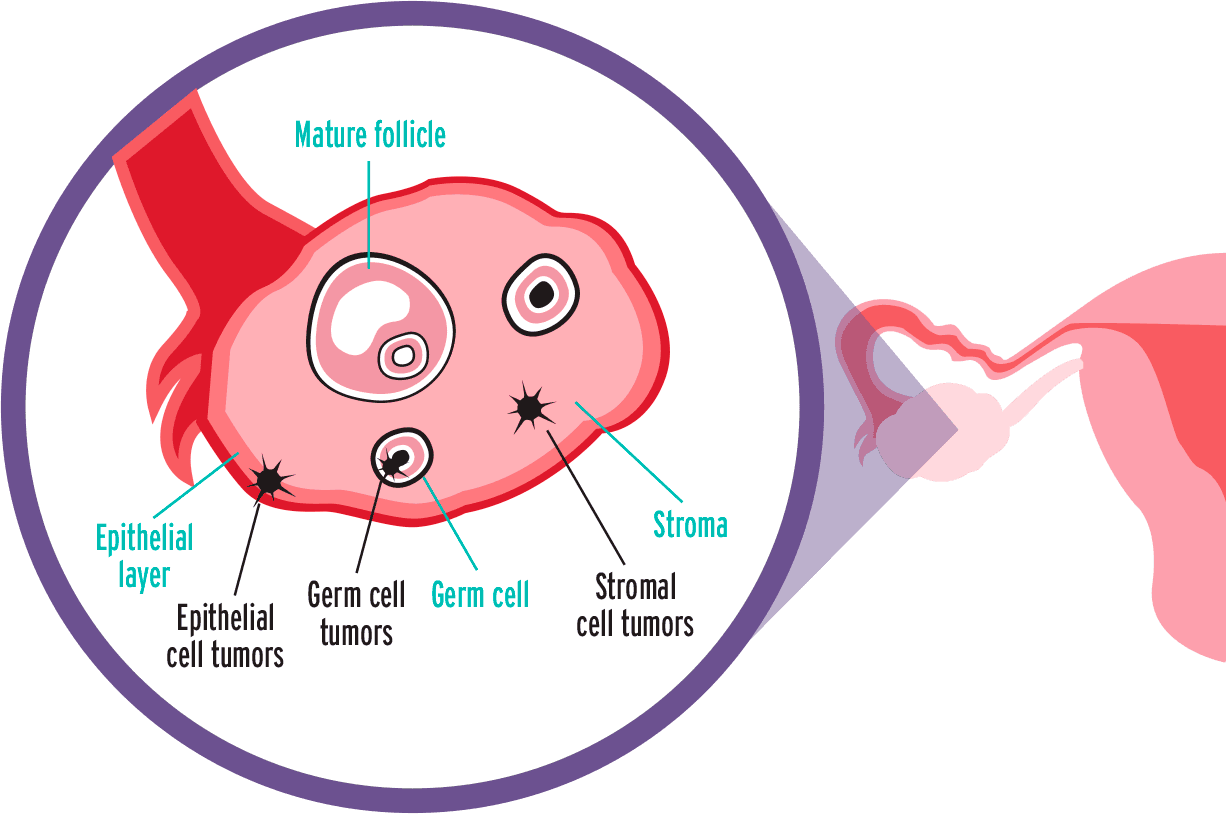Ovarian Cancer Types
Epithelial ovarian cancers are the most common and account for 85% to 89% of ovarian cancers. They form from the surface cells of the ovary or from the fallopian tube surface cells. They rank fourth in cancer deaths among people with gynecologic systems in the U.S. and cause more deaths than any other cancer of the female reproductive system.
Epithelial ovarian cancers can be a part of a hereditary or familial (genetic) syndrome such as those with BRCA1 and/or BRCA2 gene mutations. Fallopian tube and primary peritoneal cancers are also epithelial cancers and have identical behavior, risks and treatment strategies, so are included whenever epithelial ovarian cancer is discussed.
Epithelial ovarian carcinomas: Most epithelial ovarian tumors are benign. However, cancerous epithelial tumors (also known as epithelial ovarian carcinomas) are the most common type of ovarian cancer. According to the American Cancer Society, about 85 to 90 percent of ovarian cancers originate from epithelial cells, which cover the outer surface of the ovary. They commonly spread to the lining and organs of the pelvis and abdomen first before spreading to other parts of the body, such as the lungs and liver. They also may spread to the brain, bones and skin.
There are many subtypes of cancerous epithelial tumors. The most common include those below.
- Serous carcinomas: These make up 52 percent of all epithelial ovarian cancers and are often classified as low-grade serous carcinoma or high-grade carcinoma, depending on how the cancer cells look compared with normal cells. A higher grade means the cancer cells are fast-spreading and may respond best to chemotherapy.
- Endometrioid carcinomas: These tend to grow slowly and cause few symptoms. Although these tumors may be less likely to spread quickly to other areas of the body, they don’t typically respond as well to treatments.
- Mucinous carcinomas: These account for 6 percent of ovarian cancer cases and tend to affect older women. Women younger than 35 rarely are diagnosed with these slow-growing cancers.
- Clear cell carcinomas: This rare ovarian cancer has a good prognosis when caught and treated in the early stages.
Two other types of cancer are similar to epithelial ovarian cancer: primary peritoneal carcinoma and fallopian tube cancer. Because they closely resemble epithelial ovarian cancer, they’re often treated with the same approaches and techniques. Primary peritoneal carcinoma develops in the lining of the pelvis and abdomen. Fallopian tube cancer starts in the fallopian tubes. Both are rare.
Germ cell cancers are less common forms of ovarian cancer, accounting for only about 5% of ovarian cancers. Germ cell cancers start in the cells that develop into follicles or eggs in the ovaries. This cancer is usually diagnosed in adolescents and young people, and often only affects one ovary.
Some of the most common subtypes of germ cell ovarian tumors are:
- Teratomas—These germ cell tumors are either benign (mature) or cancerous (immature), and their cells may contain different types of tissue, such as hair, muscle and bone. Immature teratomas are rare.
- Dysgerminoma—Though rare, this is the most common germ cell ovarian cancer. Dysgerminomas don’t typically grow or spread quickly, but they may travel to other parts of the body, such as the central nervous system.
- Endodermal sinus tumor (yolk sac tumor) and choriocarcinoma tumors—Endodermal sinus tumors may start in the ovaries or testes, occurring most often in children. Choriocarcinomas may start in the placenta during pregnancy, which are more common, or in the ovaries. Both are extremely rare.
- Note that teenagers and women in their 20s are more likely to develop this type of ovarian cancer. Because germ cell tumors typically affect only one ovary, it’s easier to protect a woman’s fertility during treatment.
Even less common than ovarian germ cell tumors are ovarian stromal cell tumors (also called sex cord tumors and sex cord-gonadal stromal tumors), representing about 1 percent of all ovarian cancers, according to the ACS. They develop from the stroma tissue cells that produce the female hormones of estrogen and progesterone.
In the case of ovarian cancer, stromal tumors form in the tissues that support the ovaries. Of the cancerous stromal tumor subtypes, most are granulosa cell tumors. Other types include granulosa-theca tumors and Sertoli-Leydig cell tumors.
This type of ovarian cancer is often found in early stages. Vaginal bleeding is one of the most common symptoms. For post-menopausal women in particular, unexpected vaginal bleeding, among other hormonal symptoms, should prompt a conversation with a doctor.
Ovarian sarcoma: Unlike their carcinoma counterparts, ovarian sarcoma tumors develop in the connective tissues of ovarian cells. It hasn’t been studied in-depth and tends to have a poor prognosis compared with other ovarian cancers. The most common symptom is abdominal pain.
Krukenberg tumors: Krukenberg tumors are considered a stage 4 disease—an advanced cancer—because they’re metastatic in nature, meaning the cells easily break away from the original tumor and quickly multiply. This type of tumor may typically be found in the stomach, colon and ovaries. Though it’s often asymptomatic, this tumor may cause gastrointestinal symptoms.
Ovarian cysts: Ovarian cysts are fluid-filled sacs that develop inside the ovary. They’re common during ovulation and often go away on their own without treatment. Although most ovarian cysts are benign, some may develop into cancer.





